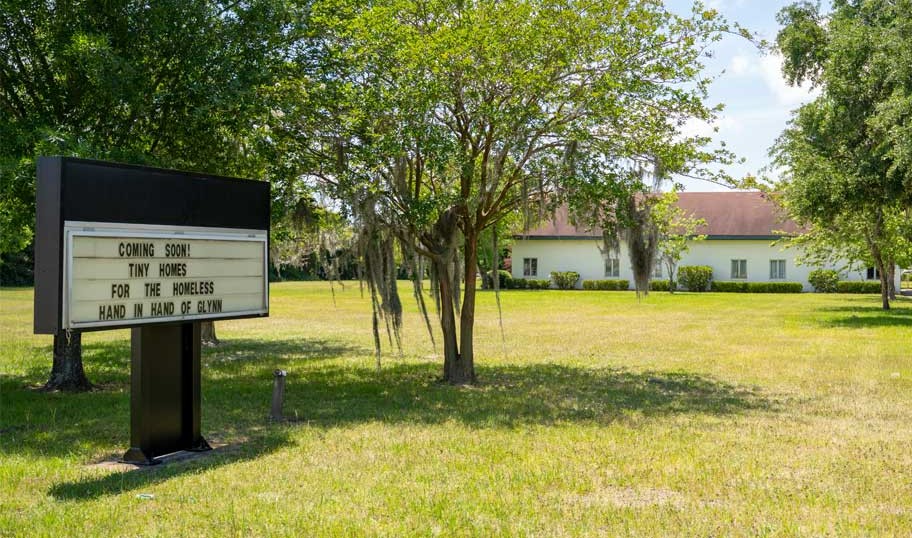Out of One Home, Many
Out of One Home, Many
By Caleb Rollins
In 2019, Altama Presbyterian Church met for the first time with Hand-in-Hand of Glynn, a nonprofit dedicated to providing permanent supportive housing to unhoused people in and around Brunswick, Georgia. This new organization wanted to purchase the church’s property to build a village of sixty tiny homes with supportive services for people experiencing homelessness in the town of about fifteen thousand people. For the members of Altama Presbyterian, this opportunity presented a near perfect solution to their real estate woes.
Struggling with the financial realities of a small and aging congregation, the church had put their building and land up for sale two years earlier. They faced mounting maintenance costs and shrinking income. “We had this big piece of property and couldn’t afford a full-time pastor,” remembers church clerk Penny Moore. While they hoped they might sell the land to another church or an organization that aligned with their mission, they knew they might instead have to sell to a developer who would knock down their sanctuary and replace it with a strip mall.
Fortunately, the leaders of Hand-in-Hand were searching for a place to put into practice their theory of housing-first homelessness support. After city planning barriers forced them to back out of another deal, Hand-in-Hand approached Altama Presbyterian. Unfortunately, even with the donations they had gathered, Hand-in-Hand could not match the sale price for the church campus. After a few conversations though, the church decided they could lower the sales price because of how the nonprofit’s mission aligned with theirs. “They have always really embraced the idea of helping others, especially the less fortunate. Everywhere is part of the church for them . . . the whole city of Brunswick,” says Altama Presbyterian pastor Rev. Jamil el-Shair.
In addition to agreeing to lower the price and wading through the rigamarole of real estate transactions, the leaders of Altama Presbyterian had to attend to some items unique to their building sale process. They met with leaders of the local presbytery to ensure that the congregation could maintain the funds from the sale rather than the monies being shared throughout the region. Furthermore, to help support the mission of Hand-in-Hand, and to shepherd along the sale of the property, members of Altama Presbyterian spoke at a local zoning board meeting in support of the tiny homes village project.
With the real estate transaction complete, the congregation was faced with another unexpected challenge: deciding what to do with all of the items, cherished and otherwise, inside their soon-to-be demolished sanctuary. With the move to their newly rented home needing to happen quickly, congregation members realized they could not save everything in the fifty-year-old building. Some items they sold; others they had to let go. Fortunately, they worked with Hand-in-Hand’s builders to save a precious stained-glass window and cross. All the while, they found space to grieve this move and the destruction of the building that had been their home for decades. Through conversation and reflection, they said goodbye and looked forward to the next chapter of their church, wherever that might be. “The church is the people. It’s not the building we are in,” reflects Moore.
After the move into their rented home, Altama Presbyterian is looking forward to using some of the funds of the sale to purchase a new permanent location for their church. Meanwhile, Hand-in-Hand has begun construction of the tiny homes village with hopes of opening in 2023. Even though they had to tear down the sanctuary, they have incorporated the old fellowship hall into their design as the community center of the village. Some of the members of Altama Presbyterian hope they might be able to come back to this fellowship hall turned community center to volunteer once the village opens. It’s a vision for this plot of land the church could not have dreamed of themselves, but through some good fortune, hard work, and self-reflection a hopeful future has begun to emerge.
This story is part of Lake Institute’s story collection, the Faithful Generosity Story Shelf, which highlights congregations and other religious organizations who have sought to use their assets and resources in creative—and sometimes surprising—ways as an expression of faithful giving.
Each entry in our Story Shelf is short enough to be read and discussed during a committee meeting or other group gathering. Our hope is that these accessible vignettes will spark new questions, conversation, and imagination among clergy and laity about what might be possible with the funds, buildings, land, and other resources in their care. If you know a story that should be included in the Story Shelf, suggest it here.
Subscribe
Insights is a bi-weekly e-newsletter for the religious community and fundraisers of faith-based organizations that provides:
- Reflections on important developments in the field of faith and giving
- Recommended books, studies and articles
- Upcoming Lake Institute events

